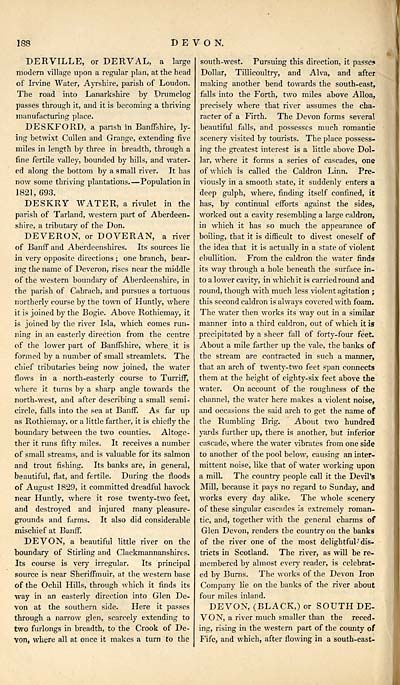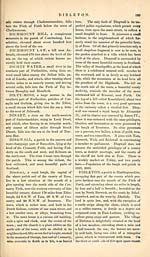Gazetteer of Scotland > Volume 1
(216) Page 188
Download files
Complete book:
Individual page:
Thumbnail gallery: Grid view | List view

188
DEVON.
DERVILLE, or DERVAL, a large
modern village upon a regular plan, at the head
of Irvine Water, Ayrshire, parish of Loudon.
The road into Lanarkshire by Drumelog
passes through it, and it is becoming a thriving
manufacturing place.
DESKFORD, a parish in Banffshire, ly-
ing betwixt Cullen and Grange, extending five
miles in length by three in breadth, through a
fine fertile valley, bounded by hills, and water-
ed along the bottom by a small river. It has
now some thriving plantations. — Population in
1821, 693.
DESKRY WATER, a rivulet in the
parish of Tarland, western part of Aberdeen-
shire, a tributary of the Don.
DEVERON, or DOVERAN, a river
of Banff and Aberdeenshires. Its sources lie
in very opposite directions ; one branch, bear-
ing the name of Deveron, rises near the middle
of the western boundary of Aberdeenshire, in
the parish of Cabrach, and pursues a tortuous
northerly course by the town of Huntly, where
it is joined by the Bogie. Above Rothiemay, it
is joined by the river Isla, which comes run-
ning in an easterly direction from the centre
of the lower part of Banffshire, where it is
formed by a number of small streamlets. The
chief tributaries being now joined, the water
flows in a north-easterly course to Turriff,
where it turns by a sharp angle towards the
north-west, and after describing a small semi-
circle, falls into the sea at Banff. As far up
as Rothiemay. or a little farther, it is chiefly the
boundary between the two counties. Altoge-
ther it runs fifty miles. It receives a number
of small streams, and is valuable for its salmon
and trout fishing. Its banks are, in general,
beautiful, flat, and fertile. During the floods
of August 1829, it committed dreadful havock
near Huntly, where it rose twenty-two feet,
and destroyed and injured many pleasure-
grounds and farms. It also did considerable
mischief at Banff.
DEVON, a beautiful little river on the
boundary of Stirling and Clackmannanshires.
Its course is very irregular. Its principal
source is near Sheriffmuir, at the western base
of the Ochil Hills, through which it finds its
way in an easterly direction into Glen De-
von at the southern side. Here it passes
through a narrow glen, scarcely extending to
two furlongs in breadth, to the Crook of De-
von, where all at once it makes a turn to the
south-west. Pursuing this direction, it passes
Dollar, Tillicoultry, and Alva, and after
making another bend towards the south-east,
falls into the Forth, two miles above Alloa,
precisely where that river assumes the cha-
racter of a Firth. The Devon forms several
beautiful falls, and possesses much romantic
scenery visited by tourists. The place possess-
ing the greatest interest is a little above Dol-
lar, where it forms a series of cascades, one
of which is called the Caldron Linn. Pre-
viously in a smooth state, it suddenly enters a
deep gulph, where, finding itself confined, it
has, by continual efforts against the sides,
worked out a cavity resembling a large caldron,
in which it has so much the appearance of
boiling, that it is difficult to divest oneself of
the idea that it is actually in a state of violent
ebullition. From the caldron the water finds
its way through a hole beneath the surface in-
to a lower cavity, in which it is carried round and
round, though with much less violent agitation ;
this second caldron is always covered with foam.
The water then works its way out in a similar
manner into a third caldron, out of which it is
precipitated by a sheer fall of forty-four feet.
About a mile farther up the vale, the banks of
the stream are contracted in such a manner,
that an arch of twenty-two feet span connects
them at the height of eighty-six feet above the
water. On account of the roughness of the
channel, the water here makes a violent noise,
and occasions the said arch to get the name of
the Rumbling Brig. About two hundred
yards further up, there is another, but inferior
cascade, where the water vibrates from one side
to another of the pool below, causing an inter-
mittent noise, like that of water working upon
a milk The country people call it the Devil's
Mill, because it pays no regard to Sunday, and
works every day alike. The whole scenery
of these singular cascades is extremely roman-
tic, and, together with the general charms of
Glen Devon, renders the country on the banks
of the river one of the most delightful' dis-
tricts in Scotland. The river, as will be re-
membered by almost every reader, is celebrat-
ed by Burns. The works of the Devon Iron
Company lie on the banks of the river about
four miles inland.
DEVON, (BLACK,) or SOUTH DE-
VON, a river much smaller than the reced-
ing, rising in the western part of the county of
Fife, and which, after flowing in a south-east-
DEVON.
DERVILLE, or DERVAL, a large
modern village upon a regular plan, at the head
of Irvine Water, Ayrshire, parish of Loudon.
The road into Lanarkshire by Drumelog
passes through it, and it is becoming a thriving
manufacturing place.
DESKFORD, a parish in Banffshire, ly-
ing betwixt Cullen and Grange, extending five
miles in length by three in breadth, through a
fine fertile valley, bounded by hills, and water-
ed along the bottom by a small river. It has
now some thriving plantations. — Population in
1821, 693.
DESKRY WATER, a rivulet in the
parish of Tarland, western part of Aberdeen-
shire, a tributary of the Don.
DEVERON, or DOVERAN, a river
of Banff and Aberdeenshires. Its sources lie
in very opposite directions ; one branch, bear-
ing the name of Deveron, rises near the middle
of the western boundary of Aberdeenshire, in
the parish of Cabrach, and pursues a tortuous
northerly course by the town of Huntly, where
it is joined by the Bogie. Above Rothiemay, it
is joined by the river Isla, which comes run-
ning in an easterly direction from the centre
of the lower part of Banffshire, where it is
formed by a number of small streamlets. The
chief tributaries being now joined, the water
flows in a north-easterly course to Turriff,
where it turns by a sharp angle towards the
north-west, and after describing a small semi-
circle, falls into the sea at Banff. As far up
as Rothiemay. or a little farther, it is chiefly the
boundary between the two counties. Altoge-
ther it runs fifty miles. It receives a number
of small streams, and is valuable for its salmon
and trout fishing. Its banks are, in general,
beautiful, flat, and fertile. During the floods
of August 1829, it committed dreadful havock
near Huntly, where it rose twenty-two feet,
and destroyed and injured many pleasure-
grounds and farms. It also did considerable
mischief at Banff.
DEVON, a beautiful little river on the
boundary of Stirling and Clackmannanshires.
Its course is very irregular. Its principal
source is near Sheriffmuir, at the western base
of the Ochil Hills, through which it finds its
way in an easterly direction into Glen De-
von at the southern side. Here it passes
through a narrow glen, scarcely extending to
two furlongs in breadth, to the Crook of De-
von, where all at once it makes a turn to the
south-west. Pursuing this direction, it passes
Dollar, Tillicoultry, and Alva, and after
making another bend towards the south-east,
falls into the Forth, two miles above Alloa,
precisely where that river assumes the cha-
racter of a Firth. The Devon forms several
beautiful falls, and possesses much romantic
scenery visited by tourists. The place possess-
ing the greatest interest is a little above Dol-
lar, where it forms a series of cascades, one
of which is called the Caldron Linn. Pre-
viously in a smooth state, it suddenly enters a
deep gulph, where, finding itself confined, it
has, by continual efforts against the sides,
worked out a cavity resembling a large caldron,
in which it has so much the appearance of
boiling, that it is difficult to divest oneself of
the idea that it is actually in a state of violent
ebullition. From the caldron the water finds
its way through a hole beneath the surface in-
to a lower cavity, in which it is carried round and
round, though with much less violent agitation ;
this second caldron is always covered with foam.
The water then works its way out in a similar
manner into a third caldron, out of which it is
precipitated by a sheer fall of forty-four feet.
About a mile farther up the vale, the banks of
the stream are contracted in such a manner,
that an arch of twenty-two feet span connects
them at the height of eighty-six feet above the
water. On account of the roughness of the
channel, the water here makes a violent noise,
and occasions the said arch to get the name of
the Rumbling Brig. About two hundred
yards further up, there is another, but inferior
cascade, where the water vibrates from one side
to another of the pool below, causing an inter-
mittent noise, like that of water working upon
a milk The country people call it the Devil's
Mill, because it pays no regard to Sunday, and
works every day alike. The whole scenery
of these singular cascades is extremely roman-
tic, and, together with the general charms of
Glen Devon, renders the country on the banks
of the river one of the most delightful' dis-
tricts in Scotland. The river, as will be re-
membered by almost every reader, is celebrat-
ed by Burns. The works of the Devon Iron
Company lie on the banks of the river about
four miles inland.
DEVON, (BLACK,) or SOUTH DE-
VON, a river much smaller than the reced-
ing, rising in the western part of the county of
Fife, and which, after flowing in a south-east-
Set display mode to: Large image | Transcription
Images and transcriptions on this page, including medium image downloads, may be used under the Creative Commons Attribution 4.0 International Licence unless otherwise stated. ![]()
| Gazetteers of Scotland, 1803-1901 > Gazetteer of Scotland > Volume 1 > (216) Page 188 |
|---|
| Permanent URL | https://digital.nls.uk/97426954 |
|---|
| Description | Volume I: Abbey to Glenartney. |
|---|---|
| Attribution and copyright: |
|
| Description | By Robert Chambers and William Chambers. Glasgow: Blackie & Son, 1838. 2 volumes. |
|---|---|
| Shelfmark | NF.1461.g.7 |
| Additional NLS resources: | |

